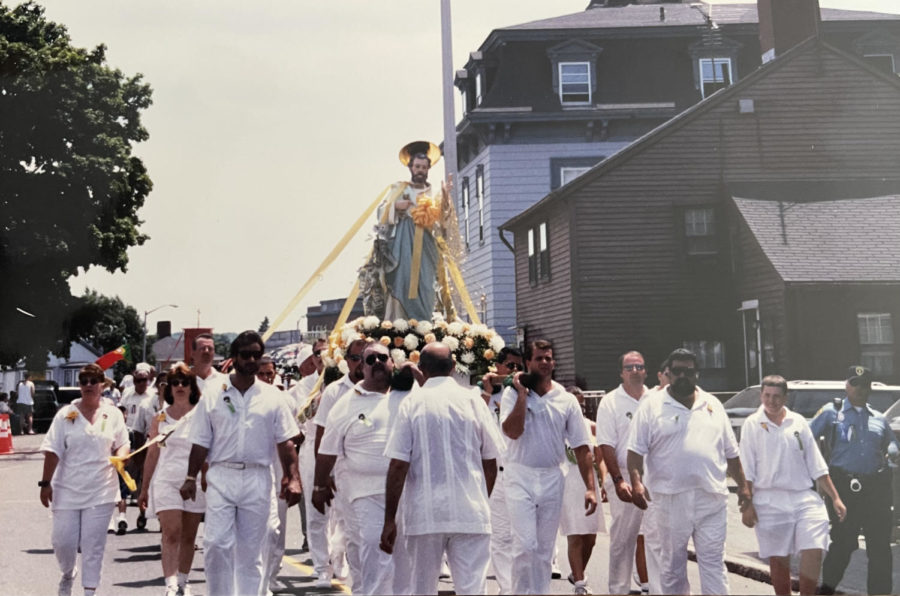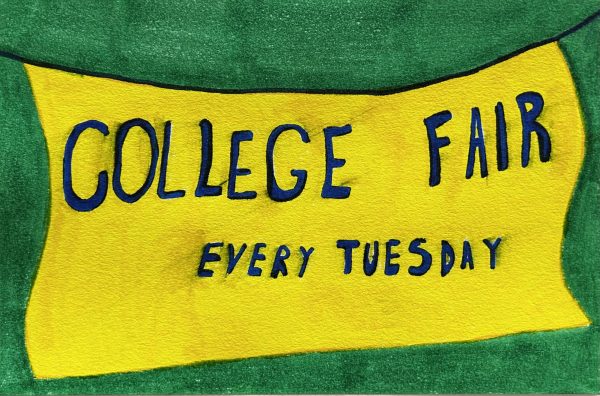Viva Feva
How one of Gloucester’s oldest traditions has changed and been preserved over time.
A vintage photo of the Sunday St. Peter’s Parade heading down Prospect Street.
Food, Family and Fun- all words often associated with Gloucester’s favorite time of the year, St. Peter’s Fiesta. However, there is one more word that may come to mind when thinking of this festive time: tradition.
Although this word doesn’t alliterate quite as well with the others, tradition is possibly the most important aspect of Fiesta.
In the Beginning
The tradition of Fiesta originated in Sicily, as a way to say thank you to the patron saint of fishermen, St. Peter, for his many blessings towards the fishermen over the course of the year.
This celebration was then brought to Gloucester in 1927 by Captain Salvatore Favazza, a Sicilian immigrant from the town of Favoratta. Favazza moved to Gloucester due to its similarities to his hometown and from there, he would become a successful sea captain.
Because of the many blessings he received while being a sea captain, Favazza decided to count his blessings in a way that hailed all the way back from his homeland- celebrating the patron saint of fishermen, St. Peter.
During this celebration, fishermen, their families, and others who joined in on the festivities would gather together to pray and dance to thank St. Peter for a good year at sea, while also asking for protection at sea, as well as another plentiful season.
These fishing families would also participate in the procession of St. Peter through their neighborhoods on the final day of the celebration, or Fiesta Sunday.
Although that may seem simple, this tradition came with many other underlying customs, including sporting and other religious events.
For sports and entertainment, men would compete in seine boat races and the now famous Greasy Pole walk to achieve the ultimate prize of bragging rights. Both of these traditions can be traced back as early as 1931.
However, the religious events that Fiesta entails can be traced back to the beginning. Many families often participated in the St. Peter’s novena, or nine days of prayer, to ask for good fortune from the sea as well as protection for their loved ones who would be out at sea. With this custom being the oldest and one of the most important, it is still cherished and practiced by many today.
People would also participate in the blessing of the fleet, where the Archbishop would come down to Gloucester’s seaport and impose a blessing onto all the ships that would go out to sea. This aspect of fiesta was introduced in 1945 and is still practiced today.
Present Day
Today, Fiesta is considered to be a celebration for all of Gloucester and more to enjoy, while still trying to maintain its traditional aspects.
Each of the traditions fiesta began with have survived the test of time, and have even grown in popularity in some cases like the Greasy Pole. However, tradition has become overshadowed by the oversized (and overpriced) carnival filled with faulty rides, carnies, and tourists.
The overshadowing has not gone unnoticed by many of Gloucester’s citizens, and oftentimes many feel passionate about the issue.
“The Carnival rides at times are pushed so close to the stage it sometimes becomes a distraction to the traditional entertainment,” said Sara Day in her book St. Peter’s Fiesta Through the Years. “To some, no doubt that Fiesta will remain just a carnival.”
“As the Fiesta grew in size and popularity, the novena became less important,” said Day. “The very purpose of the St. Peter’s Fiesta- to give praise and thanks for good fortune and protection- was becoming lost in its revelry.”
With these observations in mind, it is clear to assume that tradition is changing, but why?
The Reasons for Change
Like most things, Fiesta is something that has to change with time if it wants to survive.
Maryann Orlando, a Gloucester native who has seen 77 fiesta’s in her lifetime, recalls seeing changes.
“Today, everything is commercial. I see none of the love that I used to see,” said Orlando. “Fiesta was very different back then from what it is now. There used to be more floats and more people, it was so much better back then and I loved it.”
“Years ago, it was all about family and now I just feel like it’s not about that anymore,” said Orlando.
Orlando also recalls seeing signs along the highway advertising Fiesta to tourists. “ I wasn’t really keen on that,” said Orlando.
Throughout Orlando’s life, she has noticed many changes to the festival, including how respect towards the religious aspects of the festival have changed.
“I feel like now, the saint has just been pushed to the side because of the carnival,” said Orlando. “We never used to have the carnival years ago, there only used to be a few rides for the little kids and the rest was for either the tents or the food vendors. I feel as though it is all commercial now.”
Orlando also said that “Sunday used to be the biggest day” due to Fiesta Sunday usually landing on St. Peter’s feast day of June 30th (or close to it, at least).
Now, all the days of Fiesta are as big as the Sunday celebrations due to the crowds that the carnival draws in. However Sunday still holds importance, as the main procession takes place that day as well as closing ceremonies, the final races for seine boats, and the champions walk for the Greasy Pole.
Yet, the changes Orlando and other Gloucester citizens have noticed throughout the years have happened for a reason.
Fiesta Committee President Joe Novello offers answers that may answer many of Gloucester’s citizens’ burning questions, especially those regarding the size and significance of the carnival.
“The reason the carnival has grown so big over the past years is because the fishing community used to donate and that was the money used to put on the fiesta every year. Even though the fishing fleet has been getting smaller, the people want the fiesta to keep going,” said Novello.
“Different carnival companies have come in and made bids for how much money it will cost for a 4-5 day event,” said Novello. “They would fit as much stuff as they possibly could into that parking lot, just so that they could make their money and pay us what they owe us.”
“About 70 percent of the money made during the Fiesta is from that carnival,” said Novello.
Novello also said that once the fishing industry began to deplete, the Fiesta Committee had to turn to advertising in order to keep the tradition going.
“It was hard for a lot of people to accept,” said Novello. “But, those advertisements were never put in front of the altar because the people wanted to keep that altar sacred.”
Novello also offers insight to another question asked by Gloucester citizens: do tourists know why we celebrate?
“I think a lot of tourists know why we celebrate, but not all of them, though,” said Novello. “Once they get here and see that there are other parts of the fiesta they’ll come back again and again to see what else is there.”
“When people come to Fiesta, friendships form. After coming here once and meeting people, they’ll come back again and meet them again,” said Novello.
The Preservation
Although Fiesta has had some major changes over the years, the event has managed to preserve some of its most important elements.
The novena is quite possibly the most important part of Fiesta, and after 96 years it is still happening despite the changes the tradition has faced.
“Fiesta still has its true meaning, but during the pandemic people got concerned,” said Novello. “Even though for two years we couldn’t have that big celebration, we still held the novena and it kept the tradition going.”
“My grandfather and my grandmother’s brothers and many other families were all fishermen, to us and other members of the community appearing at this novena is our way of saying thank you,” said Gloucester native and fiesta enthusiast Elise Amaral.
“It’s important to keep up this tradition,” said Amaral. “A lot of our ancestors have hopes to keep their traditions going.”
Other traditions have also been preserved over time, including the custom of wearing the color white.
This custom can be traced back to the early years of the fiesta, when those carrying St. Peter and those on the fiesta committee wore white to honor St. Peter. Since then, the tradition has become increasingly popular with all those participating the Sunday festivities are seen to be wearing white to keep the tradition alive.

“It’s something that’s been done since the beginning,” said Novello. “It’s tradition.”
While the religious aspects are of great significance, the most popular event continues to be the Greasy Pole.
Since 1931, the tradition of the Greasy Pole has been upheld by many of Gloucester’s citizens, especially those with ties to the event.
“I come from a lineage of ‘greasy pole’ walkers, starting with my grandfather Joseph Marino who won the greasy pole all three days and was the first champion after World War II,” said Amaral.
“Since his retirement from and passing in the 80’s, I have had other family members and friends walk in his place, and this year a family friend will be walking in his honor,” said Amaral.

Since its humble beginnings, The Greasy Pole has only grown more popular, drawing in hundreds of crowds and participants over the years, all thanks to the Gloucester community keeping this staple tradition alive through the years.
Conclusion
Like many of Gloucester’s traditions, St. Peter’s Fiesta is truly one that has stood the test of time, despite how times may have changed.
Although there are plenty of new additions to the tradition, its most important and historic parts have been preserved for all of Gloucester to celebrate and carry on for future generations.
The St. Peter’s Fiesta may be changing with time, but one thing is for certain- the traditions this event has imposed will always be a part of the festivities.

Sofia Orlando is a senior at GHS and is Editor in Chief for The Gillnetter. She is a member of the National Honors Society (NHS) and has won awards for...

Elise Amaral is a senior at GHS and a third year staff writer for The Gillnetter. She is a member of the National Honors Society, and plays Lacrosse for...











![The GHS/MERHS senior cross country runners pose together on Senior Night. [Photo courtesy of Manchester-Essex Athletics]](https://thegillnetter.com/wp-content/uploads/2025/10/Screenshot-2025-10-10-at-11.18.29-AM.png)



























